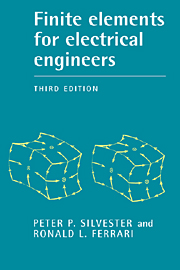Book contents
- Frontmatter
- Contents
- Preface to the third edition
- Preface to the first edition
- 1 Finite elements in one dimension
- 2 First-order triangular elements for potential problems
- 3 Electromagnetics of finite elements
- 4 Simplex elements for the scalar Helmholtz equation
- 5 Differential operators in ferromagnetic materials
- 6 Finite elements for integral operators
- 7 Curvilinear, vectorial and unbounded elements
- 8 Time and frequency domain problems in bounded systems
- 9 Unbounded radiation and scattering
- 10 Numerical solution of finite element equations
- Appendix 1 Calculations on simplex elements
- Appendix 2 Integration by parts, Green's theorems and Green's functions
- Appendix 3 Simplex element tables
- Appendix 4 Utility programs and style notes
- Appendix 5 Laboratory problems and exercises
- Index
1 - Finite elements in one dimension
Published online by Cambridge University Press: 05 June 2012
- Frontmatter
- Contents
- Preface to the third edition
- Preface to the first edition
- 1 Finite elements in one dimension
- 2 First-order triangular elements for potential problems
- 3 Electromagnetics of finite elements
- 4 Simplex elements for the scalar Helmholtz equation
- 5 Differential operators in ferromagnetic materials
- 6 Finite elements for integral operators
- 7 Curvilinear, vectorial and unbounded elements
- 8 Time and frequency domain problems in bounded systems
- 9 Unbounded radiation and scattering
- 10 Numerical solution of finite element equations
- Appendix 1 Calculations on simplex elements
- Appendix 2 Integration by parts, Green's theorems and Green's functions
- Appendix 3 Simplex element tables
- Appendix 4 Utility programs and style notes
- Appendix 5 Laboratory problems and exercises
- Index
Summary
Introduction
This chapter introduces the finite element method by showing how a simple one-dimensional problem can be solved. Subsequent chapters of this book then generalize that elementary technique to cover more complicated situations.
The illustrative problem considered in this beginning chapter is that of a lossy direct-current transmission line, a problem not only physically simple but analytically solvable that permits direct comparison of the finite element approximation with known exact solutions. Two- and three-dimensional cases are dealt with in later chapters, where both the mathematical formulation of finite elements and the relevant numerical solution techniques are dealt with.
A direct-current transmission line
Suppose a pair of buried pipes is used for transmission of electrical signals, as in Fig. 1.1(a). Such a situation may arise, for example, if gas pipelines are used to carry signals for flow measurement, flaw detection, or other communications. It will be assumed that only very low frequencies are of interest, but that the pipes are resistive so there will be some longitudinal voltage drop as well as current leakage through the earth between pipes. The transmission line formed by the pair of pipes is assumed to be driven by a voltage source (e.g., an amplifier connected to thermocouples); the receiving end is taken to be very lightly loaded, practically an open circuit. The problem is to determine the distribution of signal voltage along the line, and the voltage at the receiving end.
- Type
- Chapter
- Information
- Finite Elements for Electrical Engineers , pp. 1 - 27Publisher: Cambridge University PressPrint publication year: 1996
- 1
- Cited by

